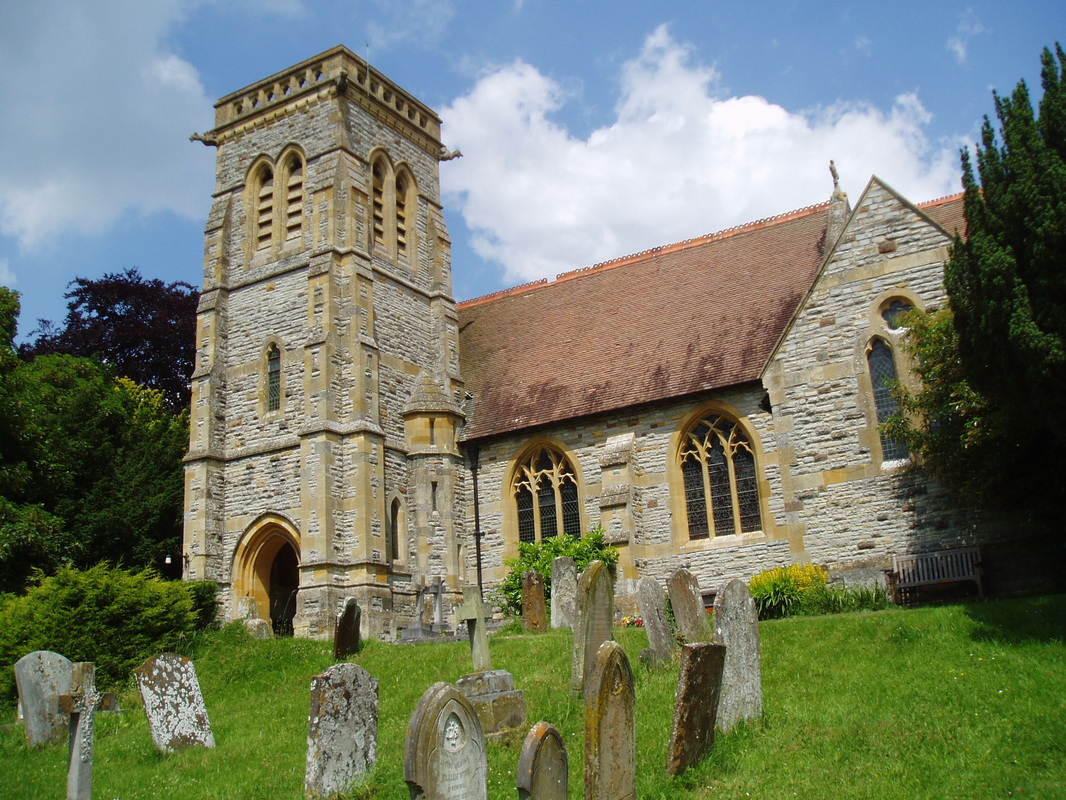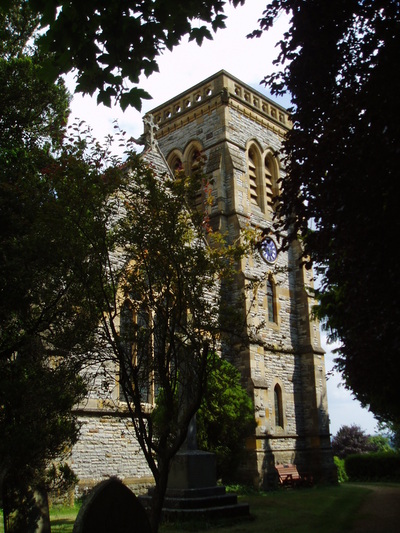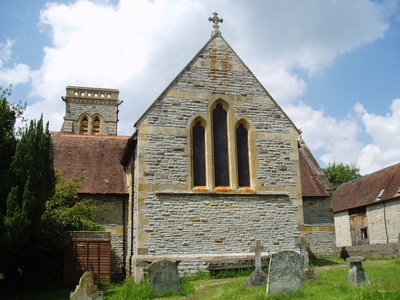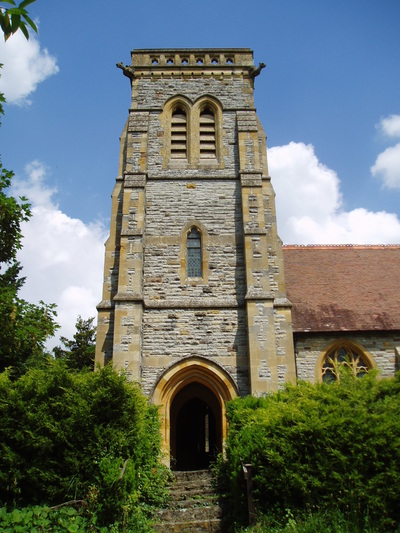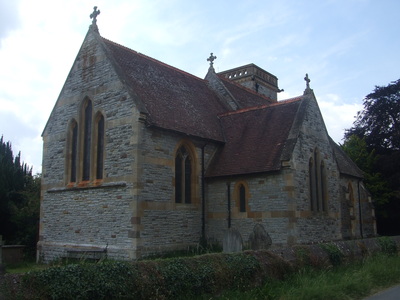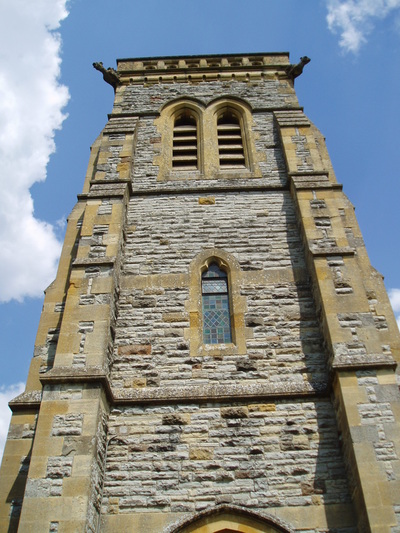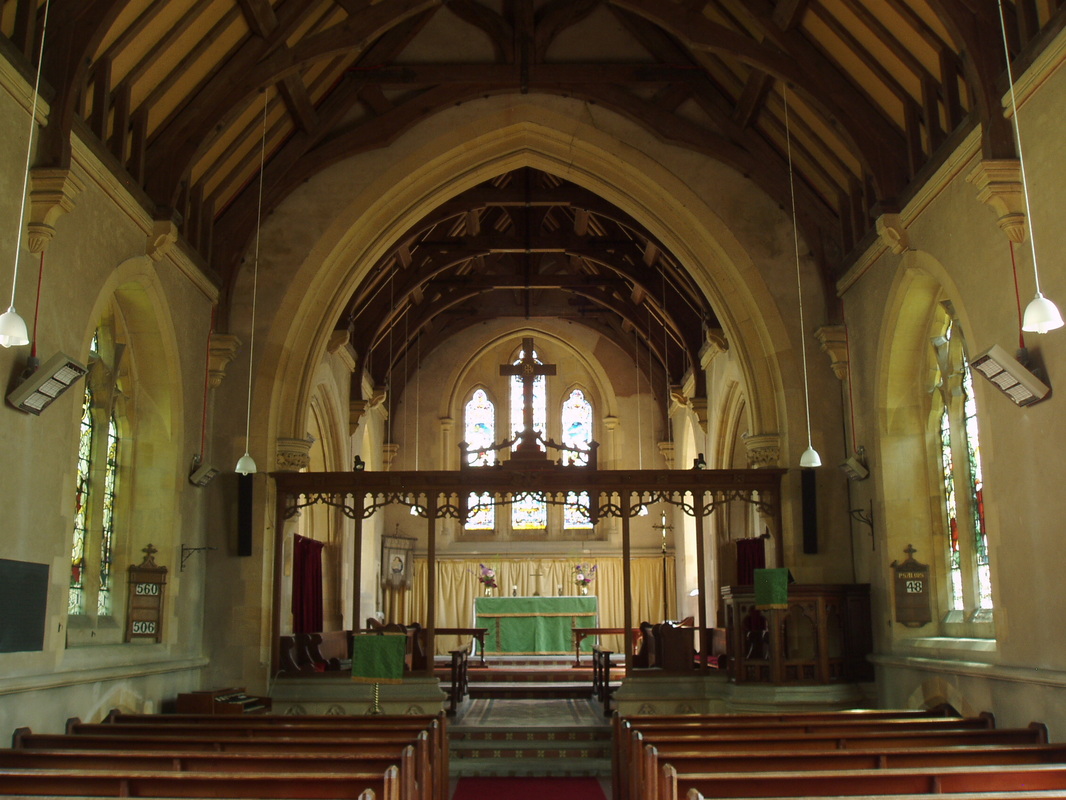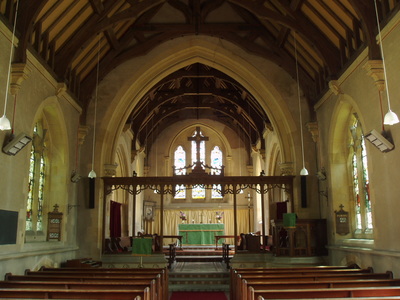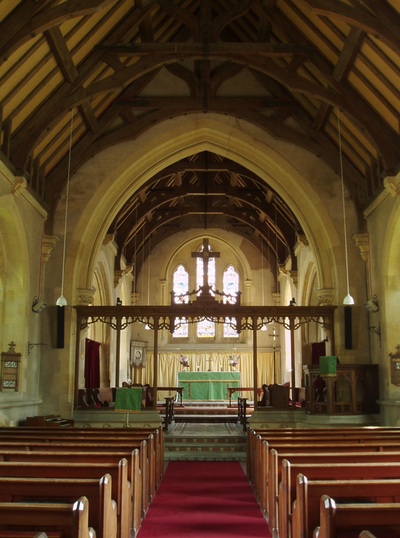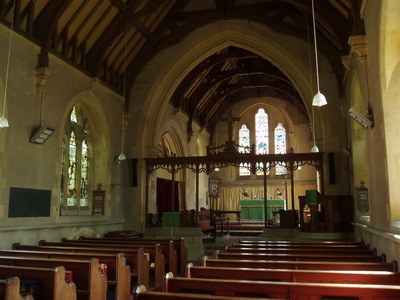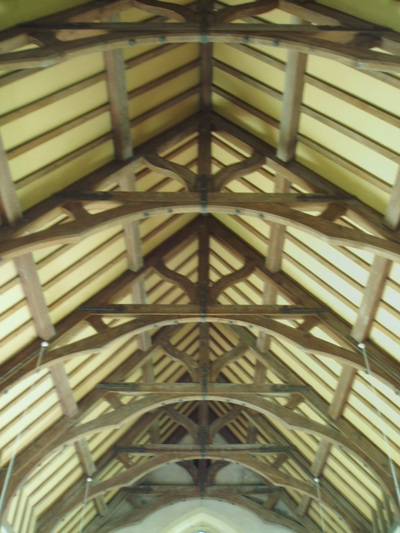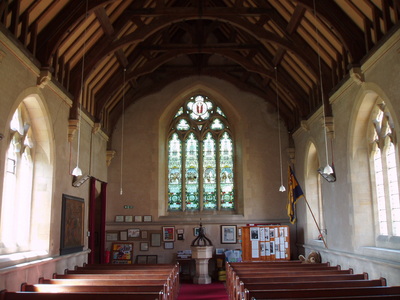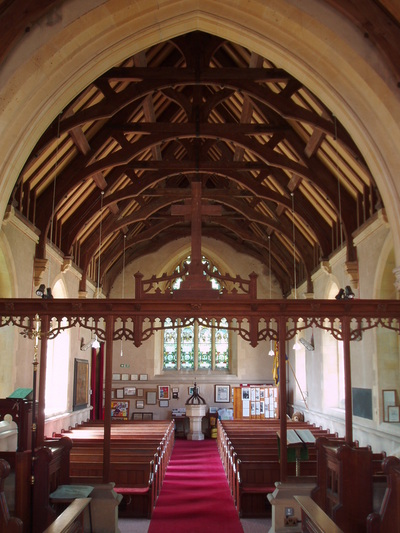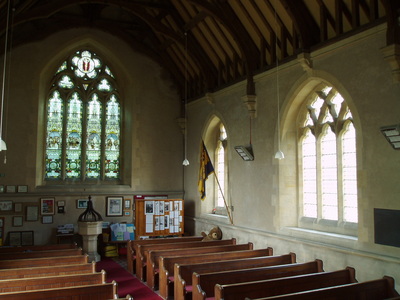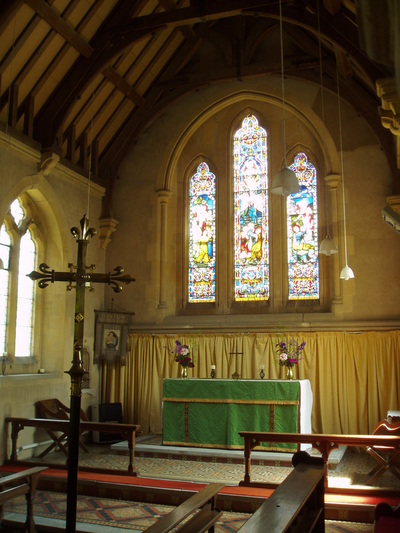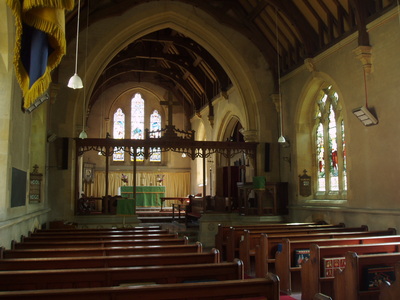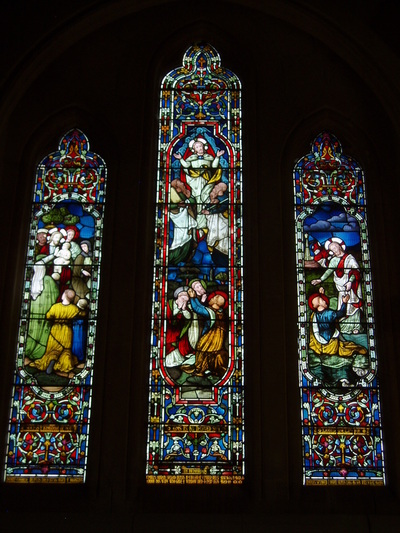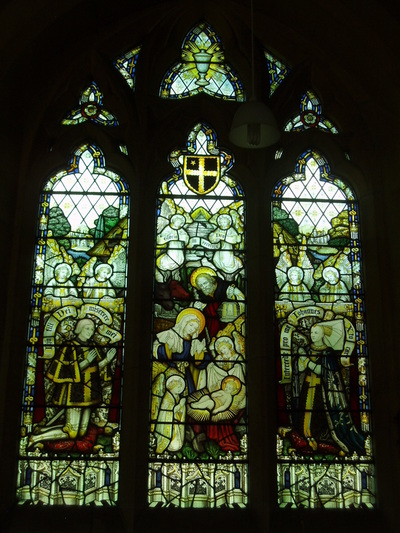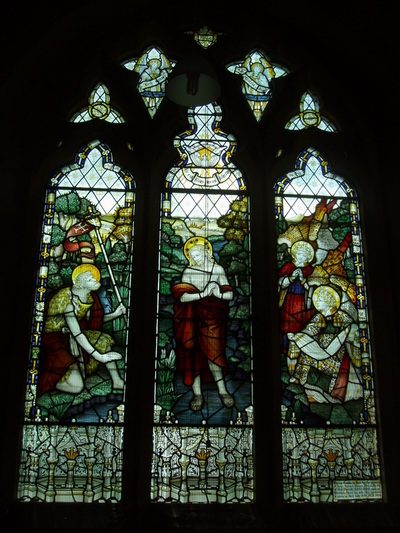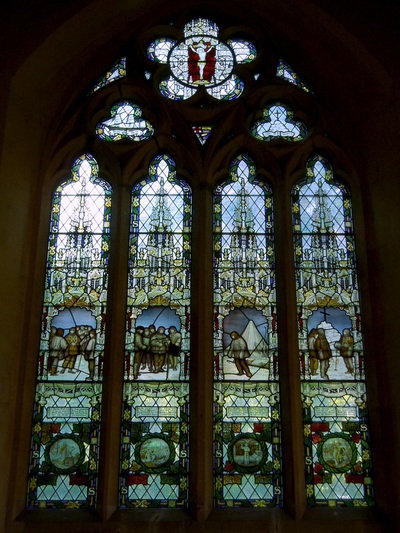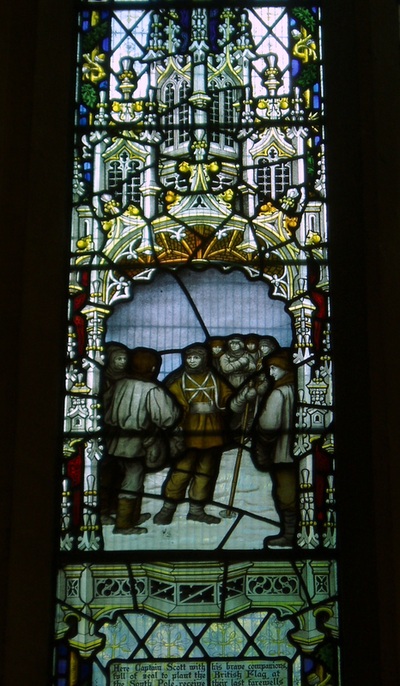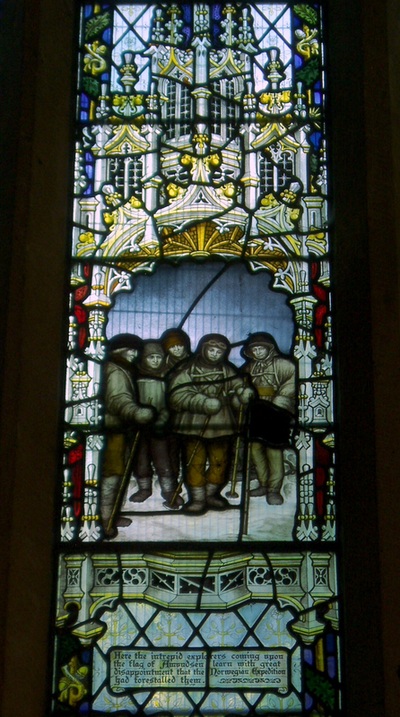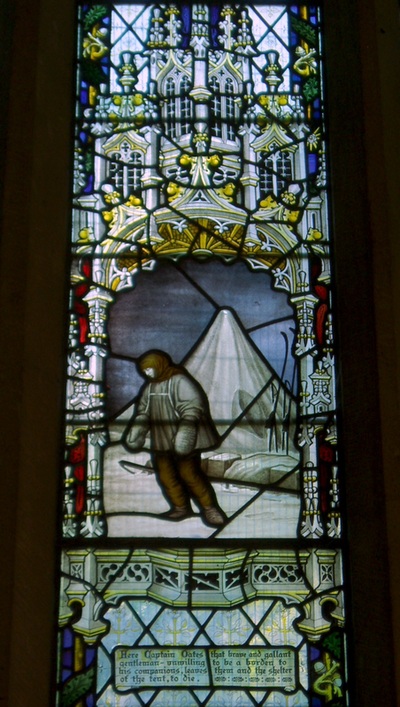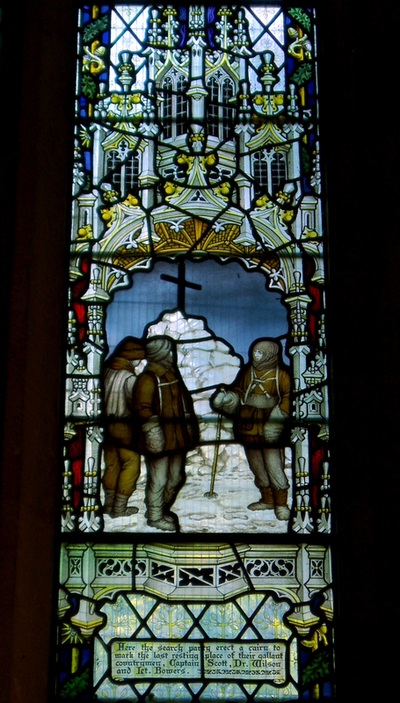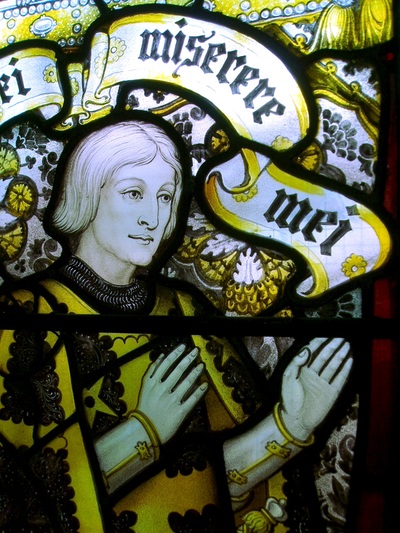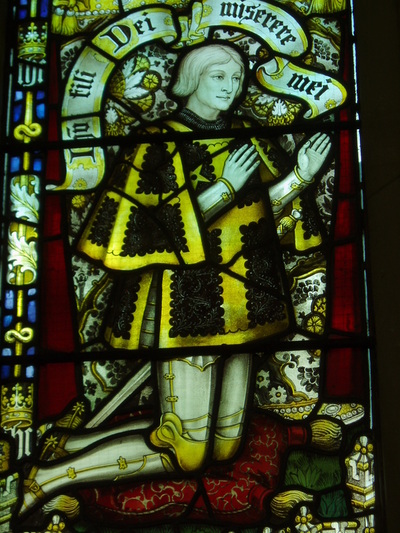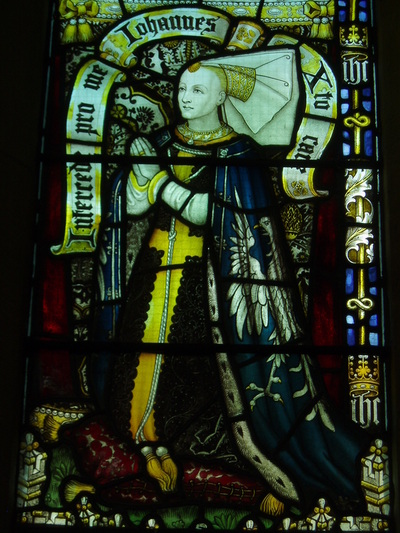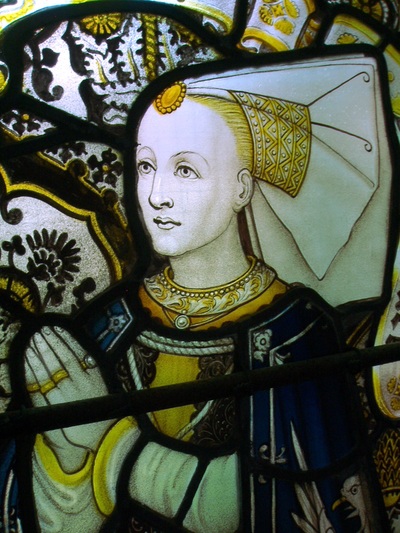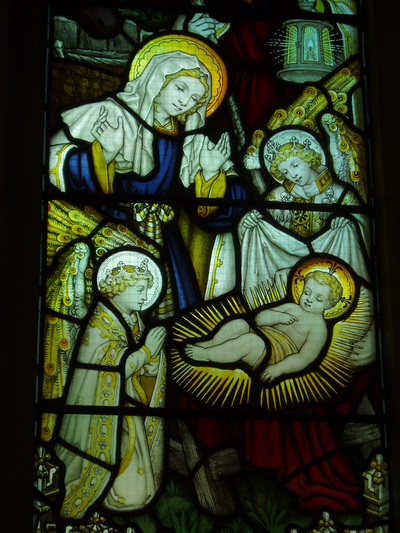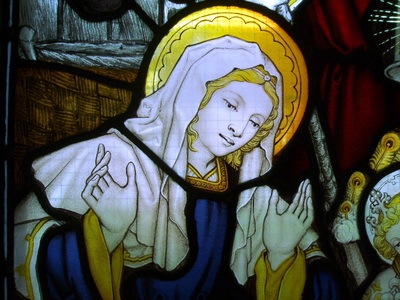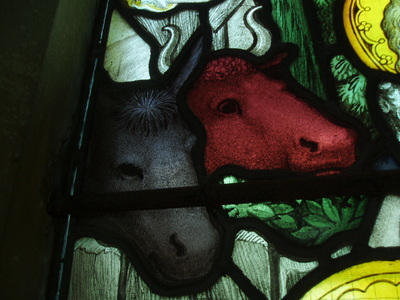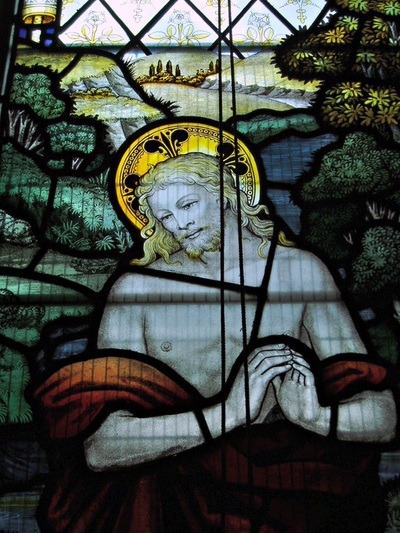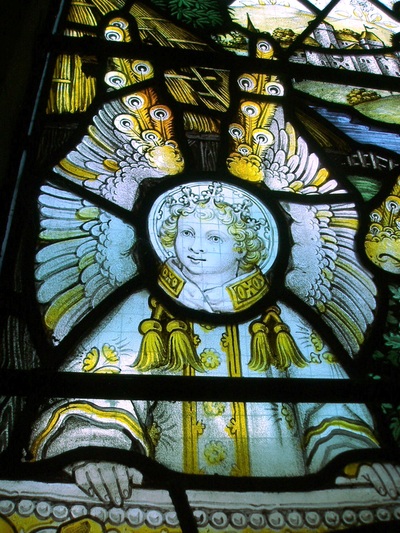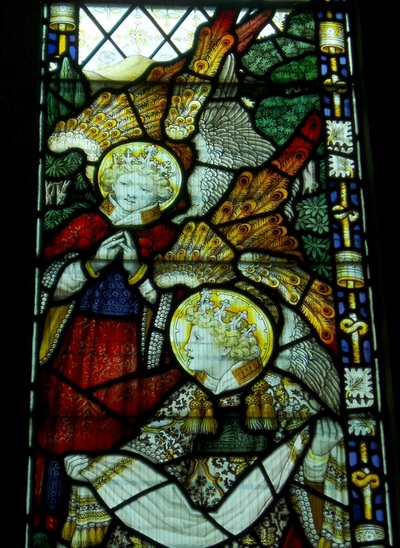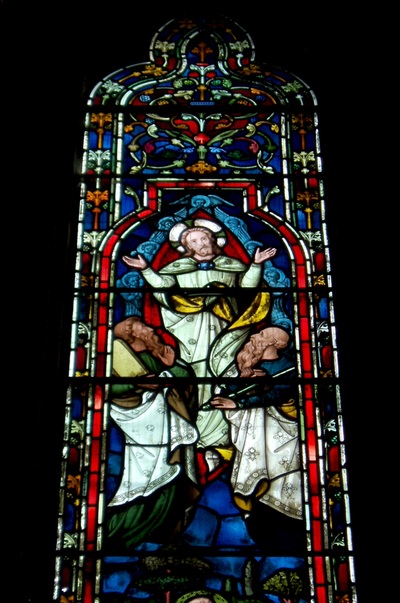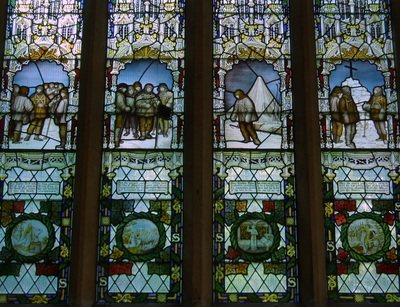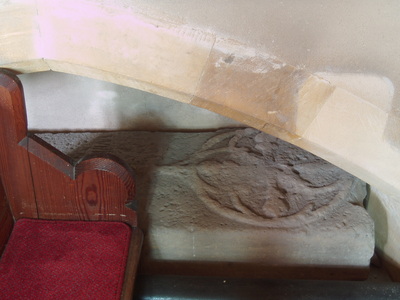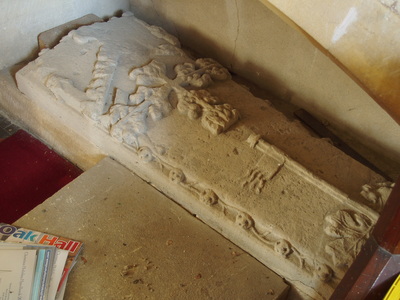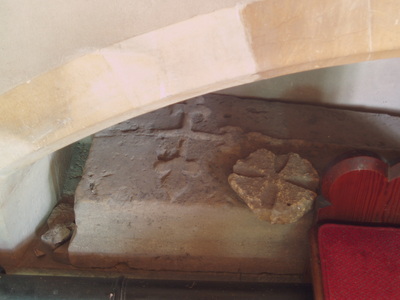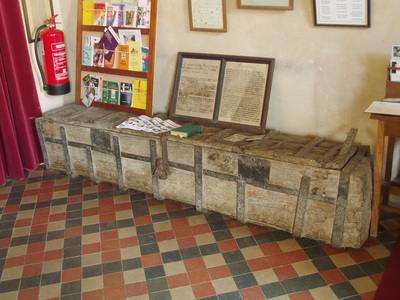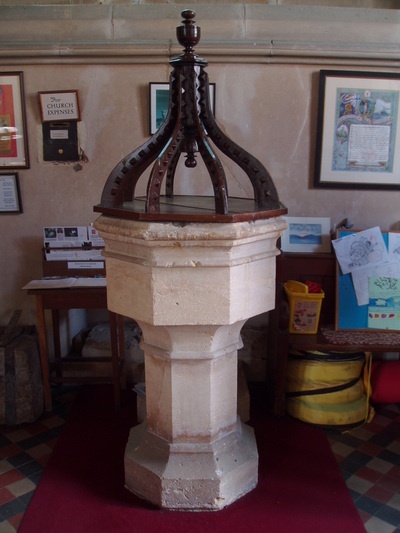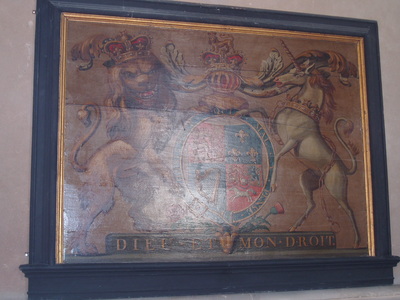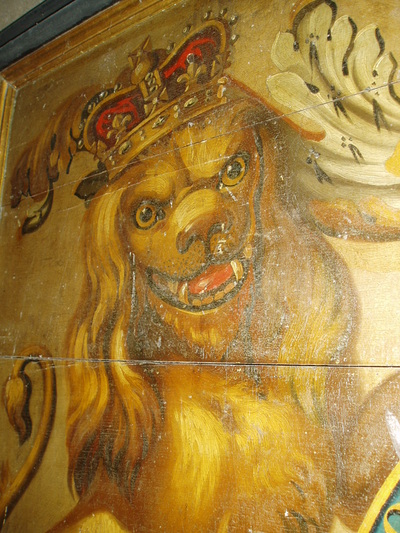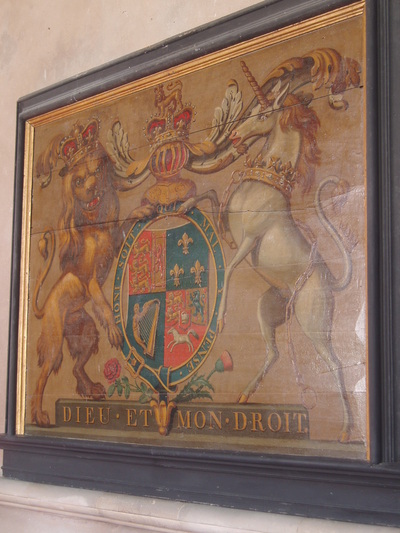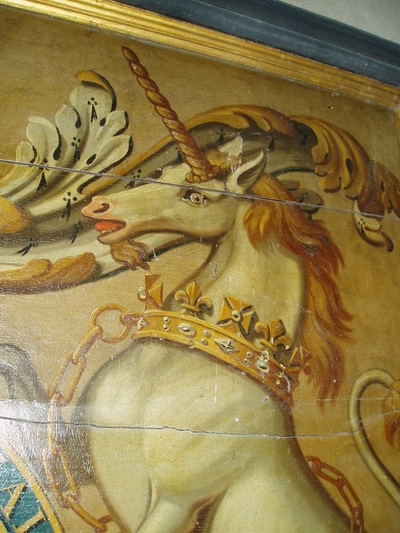Binton - St Peter
St Peter's at Binton is a church entirely rebuilt in the Victorian period, as at neighbouring Temple Grafton by Frederick Preedy in 1875-6. It has a fairly simple exterior enlivened by a handsome south-west tower, all partially hidden by trees from the main road, which adds greatly to its picturesque charm.
The church is most famous for it's Kempe glass, which is found in three windows, although it is the west window people come to see. This commemorates Scott of the Antarctic (who was married to the rector's daughter and visited Binton regularly) and portrays four scenes from his last expedition, surreally shown within Kempe's trademark Gothic canopies.
The church is most famous for it's Kempe glass, which is found in three windows, although it is the west window people come to see. This commemorates Scott of the Antarctic (who was married to the rector's daughter and visited Binton regularly) and portrays four scenes from his last expedition, surreally shown within Kempe's trademark Gothic canopies.
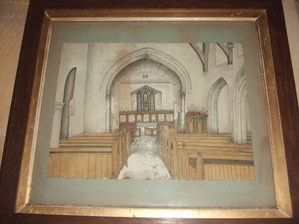
The building is entirely Victorian, leaving no trace of the medieval structure that preceeded it, although there are reminders of it still in the fittings, with three medieval carved cross slabs, along with a simple late medieval font.
An old tinted drawing of the interior of the medieval building is displayed inside the church by the main entrance from under the tower (which also serves as a porch). Its appears to have consisted of a traditional aisled nave with a smaller chancel. It was presumably a smaller and more rustic building, but looks an attractive place here, leaving one regretting that it was so utterly swept away in relatively recent times.
An old tinted drawing of the interior of the medieval building is displayed inside the church by the main entrance from under the tower (which also serves as a porch). Its appears to have consisted of a traditional aisled nave with a smaller chancel. It was presumably a smaller and more rustic building, but looks an attractive place here, leaving one regretting that it was so utterly swept away in relatively recent times.
By contrast to the old church, the present building is cruciform without aisles, and the chancel and nave are of near uniform height. The nave, uncluttered by arcades to subdivide it into greater and lesser spaces, thus has a much more spacious feel, the impression of width reinforced by the chancel being only slightly narrower. The overall colour is pale brown, from the stone dressings and the wall space which is otherwise covered with unpainted render.
Stained Glass
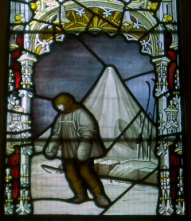
The stained glass is an important feature of this church and is unusually well balanced, with just the east and west windows and one on each side of the nave corresponding to each other. The east window is the earliest piece and is probably the work of Lavers & Westlake and dates from around the church's completion in 1876. It is a farily standard piece with a central Ascension of Christ flanked by scenes of Christ calling the children (a very popular subject with the Victorians) and Christ walking on the water, with St Peter sinking into it. The neo-medieval ornament framing the scenes adds some richness and colour.
The rest of the glass is by the studio of Charles Eamer Kempe, more muted in colour but finer in detail. The three- light windows either side of the nave depict the Nativity and Christ's baptism respectively. The figures are all very blond, as is usual with Kempe, but do include some unusual additions on the north side, with two kneeling medieval benefactors flanking the central Holy Family group, apparently based on a lost memorial (in glass or brass) in the old church. It is intriguing to see medieval characters so carefully depicted in Kempe's signature style.
The west window is of course the best known here, the memorial to Robert Falcon Scott of the Antarctic, installed in 1908 by the then vicar of Binton who was his father-in-law. The doomed expedition is recounted in four small scenes, realistically portrayed and strangely set amongst Kempe's Gothic canopy-work. The subject is strangely secular for such a large church window, and yet the image of Captain Oates saying his last farewell before walks off to die is one of the most moving images I have ever seen in a church, and a perfectly Christian example of self-sacrifice.
The rest of the glass is by the studio of Charles Eamer Kempe, more muted in colour but finer in detail. The three- light windows either side of the nave depict the Nativity and Christ's baptism respectively. The figures are all very blond, as is usual with Kempe, but do include some unusual additions on the north side, with two kneeling medieval benefactors flanking the central Holy Family group, apparently based on a lost memorial (in glass or brass) in the old church. It is intriguing to see medieval characters so carefully depicted in Kempe's signature style.
The west window is of course the best known here, the memorial to Robert Falcon Scott of the Antarctic, installed in 1908 by the then vicar of Binton who was his father-in-law. The doomed expedition is recounted in four small scenes, realistically portrayed and strangely set amongst Kempe's Gothic canopy-work. The subject is strangely secular for such a large church window, and yet the image of Captain Oates saying his last farewell before walks off to die is one of the most moving images I have ever seen in a church, and a perfectly Christian example of self-sacrifice.
Furnishings & Monuments
The church and its furnishings, aside from the delicate early 20th century wooden chancel screen, are largely all of a piece late Victorian, but there are notable exceptions and reminders of the medieval church.
Three carved medieval coffin slabs have survived, of 13th and 14th century date, all with simple cross designs and set in recesses on either side of the nave and at the west end (beneath each of the Kempe windows). Those on either side are the earliest and quite plain, but that at the west end is much more richly carved with a foliate cross under a canopy, with carved leaves at it's base and ballflower ornament along the sides, and unusuall design, luckily better preserved (and easily missed thanks to being behind the font and various bits of clutter; none of these slabs were mentioned in Pevsner).
The font too is medieval, though much later (c1520) and fairly plain; its attractive wooden cover is probably 17th century. Nearby, mounted on the south wall, is a large painted panel of the Royal Arms from the early Georgian period, which is hard to appreciate (and photograph!) owing to its shiny varnished finish. Originally it would likely have been mounted over the chancel arch of the old church, as was the norm in post-Reformation England (to remind all that the earthly regime came before the Heavenly one!). It's quite an impressive piece, with a particularly demonic looking lion!
Three carved medieval coffin slabs have survived, of 13th and 14th century date, all with simple cross designs and set in recesses on either side of the nave and at the west end (beneath each of the Kempe windows). Those on either side are the earliest and quite plain, but that at the west end is much more richly carved with a foliate cross under a canopy, with carved leaves at it's base and ballflower ornament along the sides, and unusuall design, luckily better preserved (and easily missed thanks to being behind the font and various bits of clutter; none of these slabs were mentioned in Pevsner).
The font too is medieval, though much later (c1520) and fairly plain; its attractive wooden cover is probably 17th century. Nearby, mounted on the south wall, is a large painted panel of the Royal Arms from the early Georgian period, which is hard to appreciate (and photograph!) owing to its shiny varnished finish. Originally it would likely have been mounted over the chancel arch of the old church, as was the norm in post-Reformation England (to remind all that the earthly regime came before the Heavenly one!). It's quite an impressive piece, with a particularly demonic looking lion!
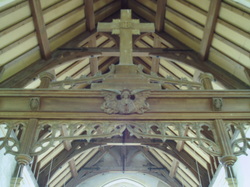
Binton church is well worth a visit despite its initial impression of lacking antiquity. The Scott association draws many, and an informative display has been set up at the west end of the nave.
The church is usually kept open and welcoming for visitors, as are many in these areas surrounding Stratford.
Aidan McRae Thomson 2014
The church is usually kept open and welcoming for visitors, as are many in these areas surrounding Stratford.
Aidan McRae Thomson 2014
